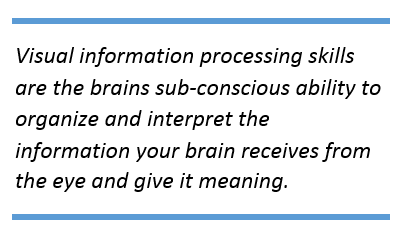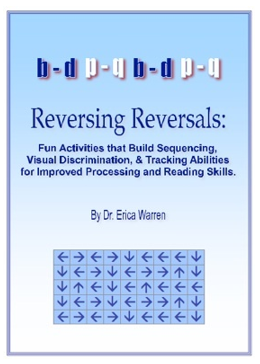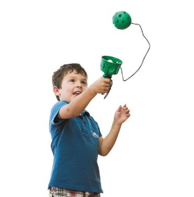The Visual Information Processing Skills

Visual Memory
The ability to remember for immediate recall of a given object or form. Children with poor visual memory may struggle with comprehension, remembering what words look like or fail to recognize on another page. Take longer copying assignments because they must frequently review the text. Visual Sequential Memory: the ability to remember shapes or characters in correct order. Children struggling with this skill will have trouble with spelling. They tend to whisper or talk to themselves as they write.
Laterality and Directionality
The ability to distinguish left and right on one's self. Good bilateral integration skills allow children to use their visual systems to monitor and adjust placement of their body weight against the gravitational forces on both sides of their body's "midline", allowing for good balance and coordination. Children with poor eye-body skills may have difficulty in such areas as sports, learning to ride a bicycle, or general "clumsiness." The ability to distinguish left and right in space. The most common cause of reversals in older children is a lack of visual spatial development. Children with poor visual processing have not developed adequate skills in visual perception and spatial orientation.
Ocular-Motor
Including both gross and fine motor skills, ocular motor skills refer to a person's ability to control the movement of the eyes so that visual information can be transmitted to the brain and then translated into commands for the rest of the body. This may be something as simple as threading a needle, placing a pencil in the correct spot on a piece of paper, or ergonomics such as sitting upright, the correct distance from your paper, and with the correct pencil grip. Deficiency in ocular motor skills can be related to underdevelopment of the midbrain reticular formation[1] or paramedian pontine reticular formation[2] in the brain.Visual Attention
The ability to maintain attention on a visual stimulus even when distractors are in place. This skill is one of the final skills that are learned in a developing mind, once other skills are firmly in place. To distract children, activities are coupled together to make them more difficult.Visualization
Read about Visualization and its related skills here. Skills related to visualization include form constancy, visual spatial relations, visual closure, discrimination, figure-ground.
January 22, 2015